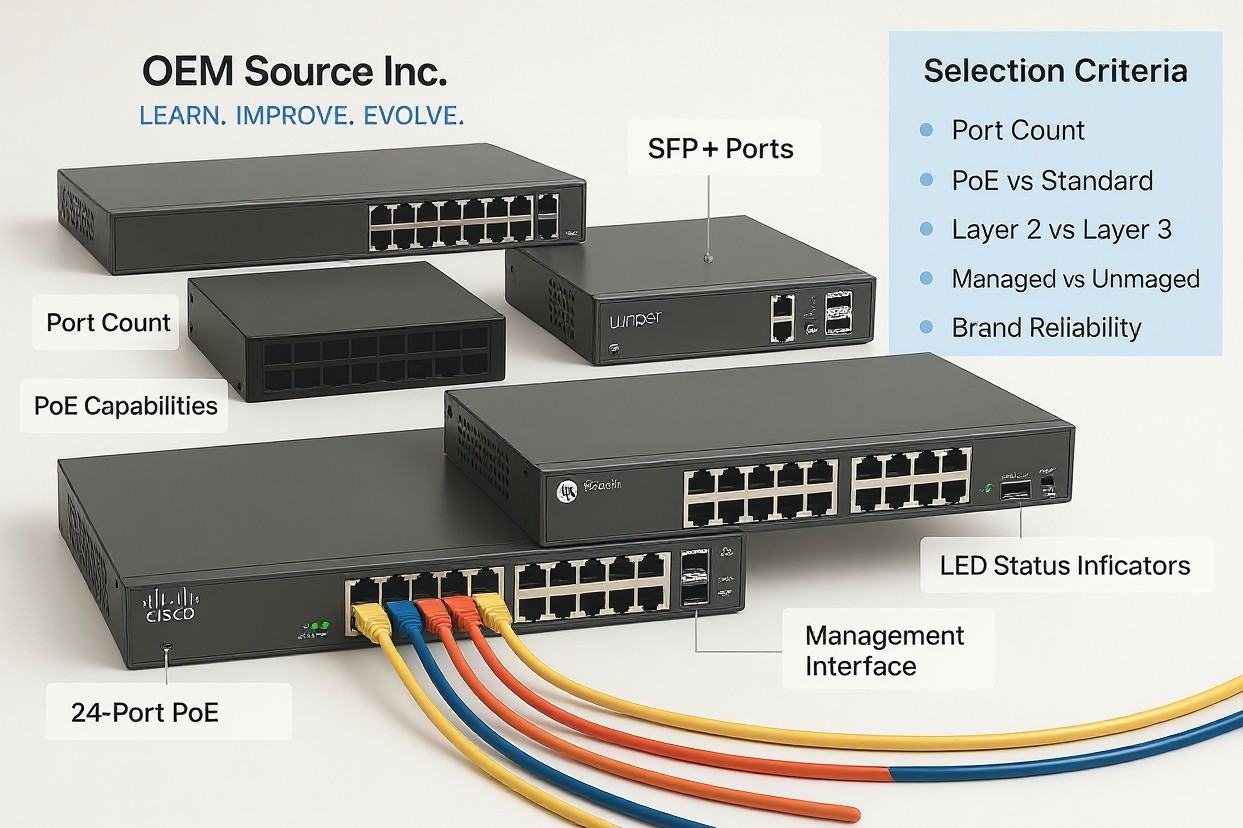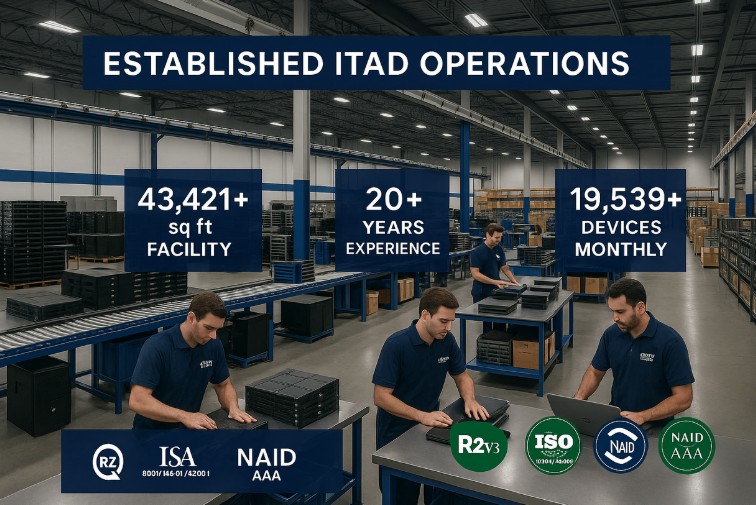The IT director stared at the budget spreadsheet in disbelief. The quote for new enterprise network switches had just arrived, and the numbers were staggering—nearly $200,000 for a complete infrastructure upgrade. With budget constraints tightening and pressure mounting to modernize their aging network, the organization faced a critical decision that would shape operations for years to come.
This scenario plays out in countless organizations worldwide as businesses struggle to balance network modernization needs with fiscal responsibility. The refurbished network equipment market offers a compelling solution, with potential savings of up to 95% off OEM list prices depending on the model, vendor, and equipment condition, all while maintaining enterprise-grade performance and reliability. However, navigating the refurbished equipment landscape requires strategic evaluation, technical due diligence, and informed decision-making to ensure optimal outcomes.
Knowing how to evaluate and select the best refurbished enterprise network switches can turn tight budgets into strategic advantages, delivering the performance, reliability, and scalability that modern businesses demand.
Understanding Network Switches
Network switches serve as the fundamental building blocks of enterprise network infrastructure, functioning as intelligent traffic directors that manage data flow between connected devices. Understanding their core functionality and importance helps organizations make informed decisions when selecting refurbished equipment.
Definition of Network Switches
Network switches are sophisticated networking devices that provide essential connectivity and traffic management capabilities:
- Data Link Layer Operation – Function at Layer 2 of the network stack, making intelligent forwarding decisions based on MAC addresses
- Switching Table Management – Maintain dynamic tables that optimize network performance and eliminate unnecessary traffic
- Dedicated Communication Pathways – Create collision-free connections between devices, unlike older hub-based networks
- Full-Duplex Communication – Enable simultaneous bidirectional data transmission to maximize bandwidth utilization
- Traffic Segmentation – Isolate network segments to improve security and reduce broadcast domains
Importance of Network Infrastructure
The importance of network infrastructure cannot be overstated in modern business operations, as organizations increasingly rely on seamless connectivity for cloud services, remote work capabilities, and digital transformation initiatives. Enterprise network switches differ significantly from consumer-grade equipment in terms of performance, management features, and reliability—they must handle substantial traffic loads while providing advanced security features and comprehensive administrative control.
Differentiating Between Switch Types
Modern enterprise environments require different types of network switches to meet varying connectivity needs, performance requirements, and management complexity levels. Understanding these distinctions helps organizations select refurbished equipment that aligns with their specific operational goals.
Unmanaged vs. Managed Switches
Unmanaged switches provide basic connectivity without configuration options, making them suitable for simple network segments where plug-and-play functionality suffices. These devices offer a cost-effective solution for straightforward needs but lack the advanced management tools required for complex enterprise environments. Managed switches, by contrast, offer robust configuration options, performance monitoring, and advanced features that allow administrators to manage traffic flow, enforce security policies, and troubleshoot connectivity issues effectively.
Ethernet vs. PoE Switches
The distinction between Ethernet and PoE switches centers on power delivery, which significantly impacts deployment flexibility.
Standard Ethernet switches transmit data only, requiring separate power sources for connected devices.
PoE (Power over Ethernet) switches deliver both data and power through the same cable, simplifying deployments and reducing infrastructure costs for devices like access points, IP phones, and security cameras..
Layer 2 vs. Layer 3 Switches
Layer 2 switches operate at the data link layer, enabling basic switching within a network through MAC address learning and forwarding.
Layer 3 switches function at the network layer and incorporate routing capabilities, allowing for inter-VLAN communication, advanced traffic management, and enhanced network segmentation essential for security and performance in larger and more complex environments.
Assessing Your Network Needs
Successful refurbished switch selection begins with a comprehensive network assessment that identifies current requirements, performance bottlenecks, and future growth projections. This evaluation process ensures that selected equipment meets immediate operational needs while providing scalability for anticipated expansion.
Evaluating Network Size and Port Count
Network size and port count requirements form the foundation of switch selection decisions. Key factors to evaluate include:
- Current Device Inventory – Assess existing computers, servers, printers, and network devices requiring connectivity
- Growth Planning – Account for expected device additions over the next 3-5 years
- Port Density Optimization – Balance the number of switches against port utilization for cost efficiency
- Distribution Strategy – Determine optimal switch placement throughout the facility
- Redundancy Requirements – Plan for backup connections and failover capabilities
- Cable Management – Consider physical layout constraints and cable routing limitations
Determining Bandwidth Requirements
Bandwidth requirements analysis involves examining current usage patterns and performance expectations. Important areas of assessment include:
- Application Traffic Analysis – Monitor usage trends and peak traffic periods
- Cloud Service Demands – Factor in increased bandwidth from cloud-based tools and SaaS platforms
- Multimedia Content – Account for video conferencing, streaming, and large file transfers
- Backplane Capacity – Confirm switches can handle aggregate traffic volumes without congestion
- Forwarding Rate Requirements – Verify packet processing speeds align with performance goals
- Buffer Memory Needs – Evaluate buffering capabilities to handle traffic bursts and prevent packet loss
Considering Future Scalability
Scalability planning should account for evolving technologies and infrastructure flexibility. Key elements include:
- Emerging Technology Support – Ensure compatibility with Wi-Fi 6, IoT devices, and next-generation protocols
- Business Growth Projections – Plan for organizational expansion and additional network loads
- Cloud Migration Strategies – Consider bandwidth and connection needs for hybrid or cloud-first architectures
- Modular Expansion Capabilities – Choose switches with upgrade paths or expansion modules
- Standards Compliance – Verify support for current and future industry standards
- Lifecycle Management – Align with refresh cycles and long-term equipment planning
Evaluating Brands and Reliability
Brand selection significantly impacts the long-term success of refurbished network switch deployments, as established manufacturers typically offer higher build quality, robust support resources, and extensive documentation to streamline implementation and ongoing management.
Trusted Brands in the Industry
Trusted networking brands have earned reputations through consistent product quality, innovation leadership, and strong customer support. Cisco Systems, in particular, dominates the enterprise networking market with an extensive product portfolio, detailed documentation, and a vast support community, making refurbished Cisco equipment especially attractive for organizations seeking proven reliability and accessible technical resources.
Comparing Brand Reliability and Support
Evaluating brand reliability involves examining failure rates, support quality, and long-term viability factors that affect the total cost of ownership. Research in reliability engineering reveals that the infant mortality phase—when devices are most prone to failure early in their lifecycle can account for 29% to 68% of all failures.. This underscores the importance of choosing refurbished equipment from reputable vendors that provide thorough testing, quality assurance, and warranty coverage.
Budget Considerations
Financial analysis is central to selecting refurbished switches, as organizations must weigh initial savings against long-term operating costs and support needs.
Analyzing Costs of Refurbished vs. New Switches
Cost comparisons reveal significant savings when choosing refurbished hardware over new alternatives. Industry data shows savings of up to 95% off OEM list prices for refurbished networking equipment. Programs like Cisco Refresh demonstrate potential savings of up to 65% compared to new equipment while maintaining enterprise-grade quality standards and performance.
Avoiding Obsolete Models
When evaluating refurbished equipment, it’s essential to avoid obsolete models that lack updated feature sets, security patches, or vendor support. Budget planning should incorporate initial acquisition costs and ongoing operational expenses such as energy usage, firmware support, and routine maintenance.
Researching Sellers
Seller evaluation represents a critical success factor in refurbished equipment procurement, as the quality of refurbishment processes, testing procedures, and support services directly impacts equipment reliability and long-term value.
Checking Seller Reputation and Credentials
Evaluating a seller’s reputation involves reviewing business credentials, industry certifications, and customer feedback that reflect reliability and service quality. Authorized resellers and certified refurbishers typically maintain higher quality standards, thorough testing procedures, and professional support services, factors that often justify premium pricing over secondary market alternatives.
Understanding Warranty and Return Policies
Warranty and return policies provide essential protection against equipment failures, compatibility issues, and post-deployment performance problems. Reputable sellers typically offer comprehensive warranties ranging from 90 days to one year, with some providers matching or exceeding manufacturer warranty terms.
Examining Delivery Options and Maintenance Support
Key seller evaluation criteria include:
- Industry Certifications and Compliance Standards – R2v3, ISO certifications, and robust quality management systems
- Testing and Refurbishment Procedures – Diagnostic testing, firmware updates, and thorough quality assurance
- Customer Support Capabilities – Technical support, configuration guidance, and troubleshooting services
Inspecting Physical and Technical Specifications
Comprehensive inspection ensures that refurbished switches meet quality standards, performance expectations, and compatibility specifications. Systematic evaluation helps verify functionality and validate seller claims before deployment.
Checking for Physical Damage
Physical damage assessment involves examining hardware condition and component integrity. Key inspection points include:
- Chassis Condition – Look for cracks, dents, or damage that may affect reliability
- Port Integrity – Inspect for corrosion, bent pins, or loose connections
- Power Supply Connections – Ensure connectors are secure and undamaged
- Cooling System Functionality – Confirm fans operate properly and air vents are unobstructed
- Component Mounting – Check that internal components are properly seated and secured
- Cosmetic Indicators – Review overall appearance for signs of rough handling or poor refurbishment
Verifying Model Specifications and Licensing
Model verification ensures the selected switch supports the required features and performance benchmarks. Important checks include:
- Port Count Confirmation – Confirm port numbers match documented specifications and requirements
- Interface Type Validation – Ensure connector (RJ45, SFP, SFP+) meet connectivity needs
- Switching Capacity Verification – Verify the backplane bandwidth can handle the expected traffic
- Feature Set Documentation – Validate support for VLAN, QoS, and management function
- Firmware Version Status – Confirm current software is up to date and stable
- Licensing Compliance – Ensure software licenses are included and transferable as needed
Ensuring Compatibility
Compatibility assessments verify that switches will function seamlessly within your existing network. Critical factors include:
- VLAN Support Verification – Confirm VLAN capabilities match network segmentation requirements
- Routing Capability Assessment – Validate Layer 3 support for inter-VLAN routing
- Management Interface Compatibility – Ensure integration with current management platforms
- Protocol Support Validation – Confirm support for all required networking standards
- Cable and Connector Compatibility – Check for alignment with the current cabling infrastructure
- Power Requirements Alignment – Make sure power specifications match the facility’s capacity
Testing and Firmware Updates
Comprehensive testing procedures validate equipment functionality, performance characteristics, and integration compatibility before deployment in production environments. Systematic testing helps identify issues early, confirm operational capabilities, and ensure refurbished equipment meets enterprise requirements.
Ensuring System Integration Compatibility
System integration testing verifies that refurbished switches communicate effectively with existing network infrastructure, management systems, and connected devices. Organizations should conduct connectivity tests, protocol compatibility checks, and management interface validation to ensure smooth deployment.
Essential testing procedures include:
- Power-On Diagnostics and Hardware Verification – Confirm that all components initialize and function properly
- Port Connectivity and Cable Compatibility Testing – Validate that ports and cables function across intended bandwidths
- Protocol Support and Feature Validation – Ensure availability of required protocols and software features
- Performance Benchmarking and Throughput Testing – Confirm advertised performance metrics under load
- Management Interface and Monitoring Capability Verification – Validate administrative access and visibility via monitoring platforms
Essential Features to Consider
Modern enterprise switches include advanced features that enhance performance, security, and manageability. Understanding these capabilities helps organizations select refurbished equipment that delivers long-term operational value.
Quality of Service (QoS)
Quality of Service enables traffic prioritization and bandwidth allocation, ensuring critical applications maintain performance. This is especially important for real-time communications, video conferencing, and cloud workloads that compete for bandwidth.
Traffic Prioritization and Management
Traffic management features let network administrators implement policies across applications and endpoints. These capabilities include traffic classification, queue scheduling, and bandwidth reservations to maintain consistent service quality.
Energy Efficiency
Energy efficiency considerations impact long-term operational costs and sustainability goals. Features like Energy Efficient Ethernet (EEE) and dynamic power management reduce consumption without sacrificing performance.
Environmental Benefits of Refurbished Switches
Beyond energy savings, refurbished switches support broader sustainability goals by extending product lifecycles, conserving resources, and reducing e-waste. Professional refurbishment supports circular economy principles and contributes to carbon footprint reduction.
Key Takeaways for Choosing Refurbished Enterprise Network Switches
Selecting the best refurbished enterprise switches requires a strategic blend of technical insight, budget analysis, and long-term planning. Organizations that approach procurement methodically can reduce costs and maintain high network standards.
Key success factors include:
- Partnering with trusted sellers offering warranty-backed equipment
- Conducting detailed inspections and compatibility assessments
- Implementing thorough testing before deployment
OEM Source helps IT leaders unlock the full value of refurbished networking hardware through certified equipment, expert support, and end-to-end asset lifecycle services. Whether you’re upgrading your infrastructure, expanding your network, or managing IT assets at scale, our team ensures your switches are ready to perform—efficiently, securely, and sustainably.
Frequently Asked Questions
What are the benefits of refurbished network switches?
Refurbished network switches offer significant cost savings, often up to 95% compared to new equipment, while maintaining enterprise-grade performance and reliability. Additional benefits include reduced environmental impact through extended equipment lifecycles, access to proven technology platforms with extensive documentation, and the flexibility to upgrade networks within constrained budgets. Quality refurbished switches typically include full diagnostic testing, warranty coverage, and expert support services.
How do you maintain refurbished switches for long-term use?
Maintaining refurbished switches involves implementing regular monitoring, timely firmware updates, and proper environmental controls (e.g., temperature and humidity). Preventive maintenance should include internal cleaning, physical inspection, and periodic component verification. Keeping backup configurations and documenting any network changes also supports long-term reliability. Partnering with a qualified support provider can extend the lifespan of refurbished equipment.
Are refurbished switches reliable for mission-critical environments?
Yes. When sourced from reputable sellers with comprehensive testing and quality assurance processes, refurbished switches can match or exceed the reliability of new equipment. Look for providers that offer warranty coverage, professional refurbishment standards, and proven performance metrics to ensure compatibility with mission-critical deployments.
What should you look for when choosing a refurbished switch seller?
Key criteria include industry certifications (such as R2v3 or ISO), detailed refurbishment and testing procedures, clear warranty and return policies, and positive customer reviews. Reputable sellers provide documentation, technical support, and transparent product grading that reflect the condition and functionality of each unit.
Do refurbished switches support the latest networking standards?
Many refurbished switches support current networking standards such as Gigabit Ethernet, PoE+, VLAN tagging, and Layer 3 routing. However, compatibility varies by model. Always verify feature sets, firmware support, and interface types to ensure alignment with your network’s requirements and future growth plans.





